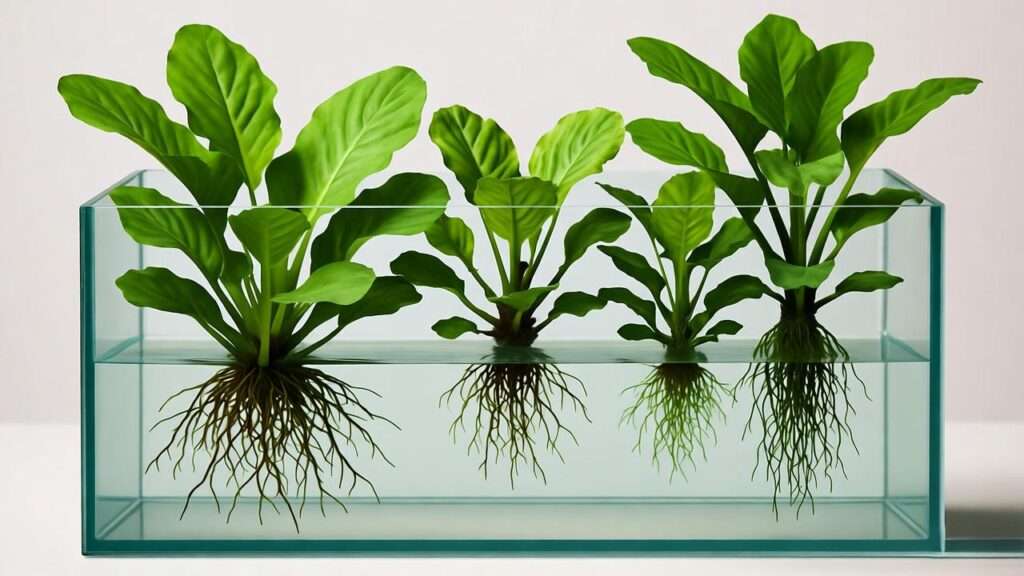Picture this: a shimmering aquarium where lush green foliage dances on the water’s surface, fish dart playfully beneath, and the water stays crystal-clear with minimal effort. Sounds like a dream, right? Welcome to the magic of floating aquarium plants! These aquatic wonders are the secret weapon for aquarists seeking a low-maintenance, vibrant tank that’s as healthy as it is beautiful. Whether you’re a beginner or a seasoned aquascaper, floating aquarium plants offer unmatched benefits: natural filtration, effortless care, and stunning aesthetics. In this comprehensive guide, we’ll explore the top 10 floating aquarium plants, their care requirements, and expert tips to transform your tank into a thriving ecosystem. Written by an aquascaping enthusiast with over a decade of experience, this article will help you choose the perfect plants to elevate your aquarium game. Let’s dive in! 🐟
What Are Floating Aquarium Plants and Why Should You Care? 🌿
Understanding Floating Aquarium Plants
Floating aquarium plants are unique aquatic species that thrive on or just below the water’s surface, requiring no substrate or anchoring. Unlike rooted plants, they float freely, soaking up nutrients directly from the water column. Their fast-growing nature and adaptability make them ideal for aquarists of all levels. From tiny Duckweed to lush Water Lettuce, these plants are powerhouses of functionality and beauty, perfect for creating a natural, balanced tank environment.
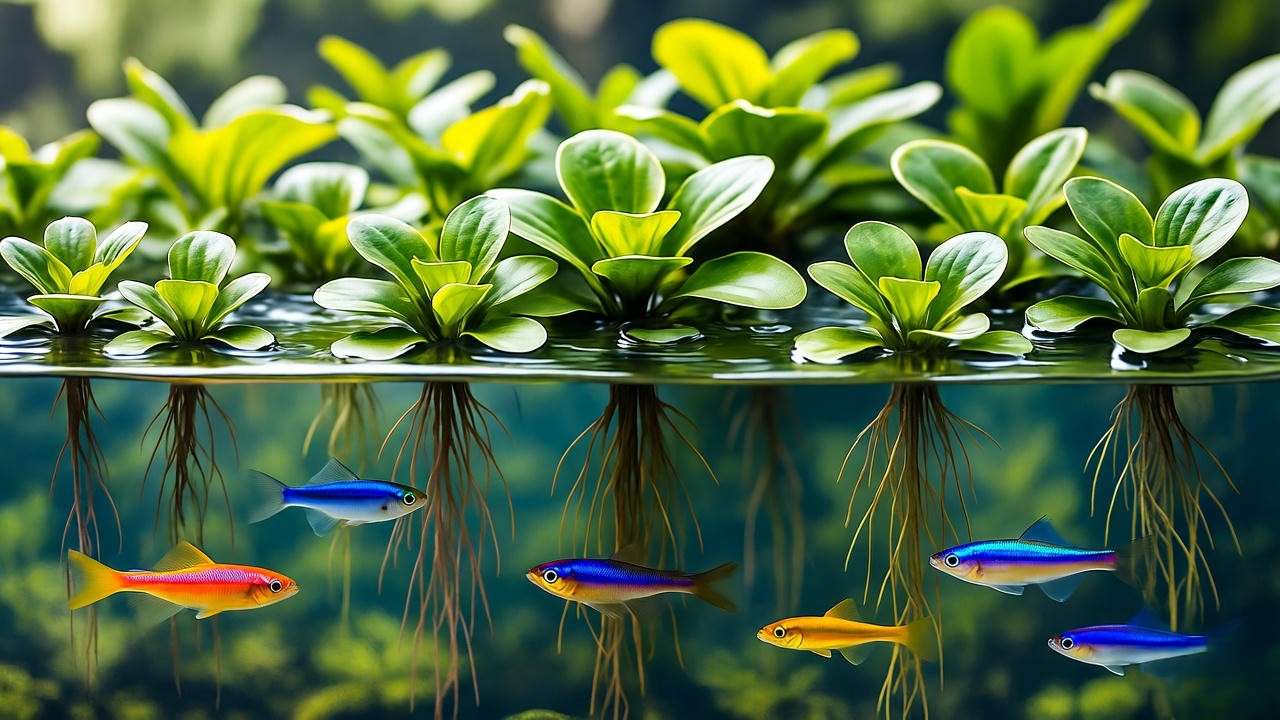
Benefits of Floating Plants for Your Aquarium 🐟
Why choose floating plants? Here’s why they’re a must-have:
- Water Purification: Floating plants absorb nitrates, ammonia, and other pollutants, acting as natural filters to reduce algae growth and keep water pristine.
- Oxygenation: They release oxygen during photosynthesis, boosting water quality and supporting fish health.
- Aesthetic Appeal: Their lush greenery adds texture, depth, and a natural vibe to any tank.
- Fish-Friendly: They provide shade, hiding spots, and breeding grounds for fish and fry, reducing stress and encouraging natural behaviors.
- Low Maintenance: No soil, no planting, no fuss—just drop them in and watch them thrive!
Expert Tip: Floating plants are a beginner’s best friend, offering high impact with minimal equipment or expertise. Pair them with a simple LED light for stunning results! 🌱
Top 10 Floating Aquarium Plants for a Vibrant, Healthy Tank 🌊
Let’s explore the top 10 floating aquarium plants, each handpicked for their beauty, ease of care, and tank-enhancing benefits. Each section includes a description, care tips, benefits, and ideal tank conditions to help you choose wisely.
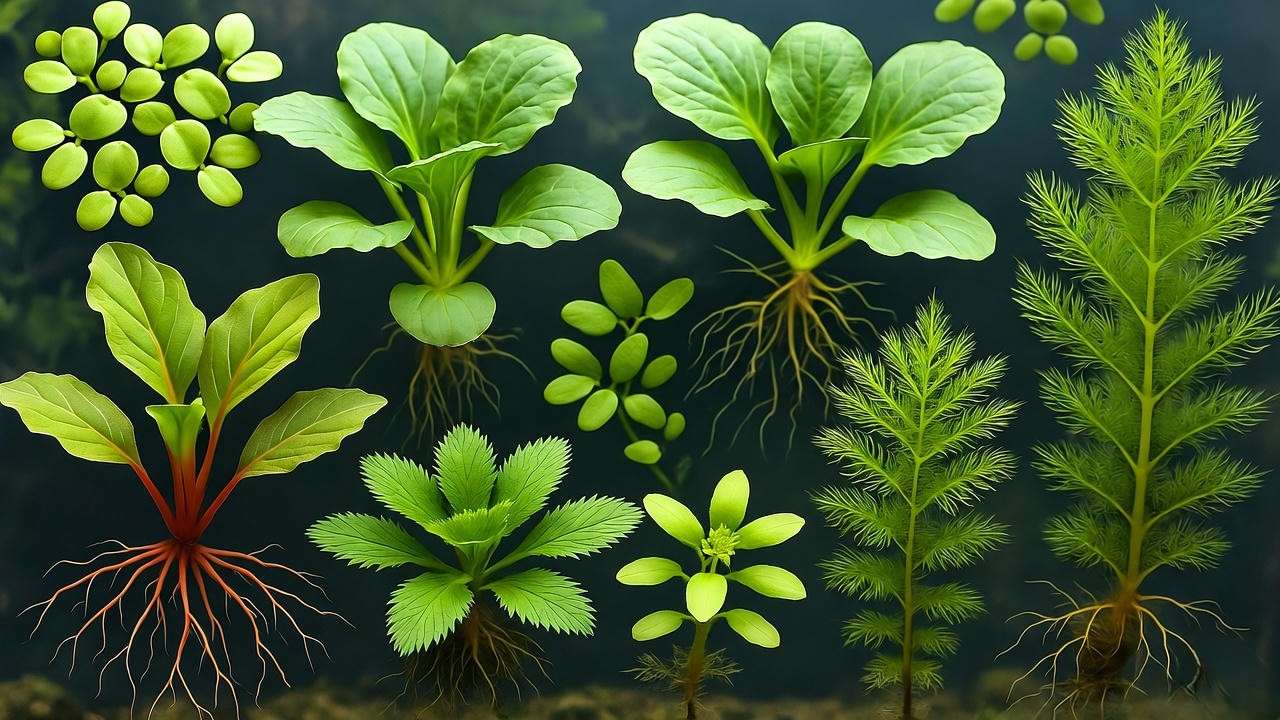
1. Duckweed (Lemna minor) 🦆
Description: Duckweed is the smallest floating plant, forming a carpet of tiny, round green discs on the water’s surface. Its rapid growth makes it a favorite for nutrient control.
Care: Thrives in low to moderate light (5-15W), adapts to a wide range of water conditions (pH 6.0-7.5, 60-80°F), and requires occasional thinning to prevent overgrowth.
Benefits: Absorbs nitrates like a sponge, provides shade for light-sensitive fish, and supports biofilm for shrimp and fry.
Ideal for: Beginners, nano tanks, and betta fish setups.
Pro Insight: Pair Duckweed with cherry shrimp for a self-cleaning tank—shrimp love grazing on its roots!
2. Water Lettuce (Pistia stratiotes) 🥬
Description: With its rosette-shaped, lettuce-like leaves, Water Lettuce adds a tropical flair to any tank. Its long roots dangle below, creating a natural curtain.
Care: Prefers moderate to high light (15-25W), warm water (70-80°F), and good water flow. Avoid cold temperatures below 65°F.
Benefits: Reduces algae by soaking up nutrients, provides shade for shy fish, and enhances tank aesthetics.
Ideal for: Tropical tanks, large aquariums, and outdoor ponds.
3. Amazon Frogbit (Limnobium laevigatum) 🌸
Description: Amazon Frogbit boasts heart-shaped leaves and long, feathery roots, creating a lush canopy on the water’s surface.
Care: Needs low to moderate light (10-20W), warm water (68-82°F), and occasional root trimming to maintain tidiness.
Benefits: Balances tank nutrients, shelters fry, and adds a natural, serene vibe.
Ideal for: Community tanks and low-tech aquascapes.
4. Water Hyacinth (Eichhornia crassipes) 💜
Description: Known for its bulbous, buoyant stems and vibrant green leaves, Water Hyacinth is a showstopper in large tanks.
Care: Requires high light (20W+), nutrient-rich water, and warm temperatures (72-82°F). Not suited for small tanks due to its size.
Benefits: Absorbs pollutants, adds dramatic flair, and thrives in nutrient-heavy setups.
Ideal for: Advanced aquarists with spacious tanks or outdoor water gardens.
5. Salvinia (Salvinia minima) 🌿
Description: Salvinia features small, oval leaves with a velvety texture, forming a delicate floating mat.
Care: Thrives in moderate light (10-15W), warm water (68-80°F), and minimal maintenance. Thin regularly to avoid overcrowding.
Benefits: Controls nutrients, provides shade, and adds a soft texture to the tank.
Ideal for: Small to medium tanks with peaceful fish like guppies or tetras.
6. Red Root Floater (Phyllanthus fluitans) ❤️
Description: This striking plant features green leaves with vibrant red roots, turning redder under high light for a dramatic effect.
Care: Needs high light (20W+) for vivid color, nutrient-rich water, and occasional pruning. Prefers 70-82°F.
Benefits: Adds a pop of color, absorbs excess nutrients, and enhances visual appeal.
Ideal for: Aquascapers seeking a bold, colorful tank.
7. Water Spangles (Salvinia auriculata) ✨
Description: Similar to Salvinia minima but with larger, more structured leaves, Water Spangles create a lush, textured surface.
Care: Moderate light (10-20W), warm water (70-80°F), and gentle water flow. Thin as needed.
Benefits: Supports biofilm for shrimp, provides shade, and controls nitrates.
Ideal for: Shrimp tanks and low-flow setups.
8. Floating Crystalwort (Riccia fluitans) 🌟
Description: This bright green, moss-like plant can float or be attached to decor, offering versatility in aquascaping.
Care: Prefers moderate to high light (15-25W), thrives in 65-80°F, and benefits from occasional trimming.
Benefits: Oxygenates water, supports creative layouts, and provides fry protection.
Ideal for: Aquarists who love experimenting with tank designs.
9. Azolla (Azolla filiculoides) 🌱
Description: A fern-like plant with reddish-green hues under bright light, Azolla adds a unique aesthetic to tanks.
Care: Adapts to low to high light (5-20W), prefers nutrient-rich water, and thrives in 60-80°F.
Benefits: Fixes nitrogen, supports eco-friendly tanks, and grows quickly.
Ideal for: Sustainable aquariums and outdoor ponds.
10. Hornwort (Ceratophyllum demersum) 🌾
Description: This feathery, bushy plant can float or be anchored, offering flexibility for various tank setups.
Care: Thrives in low to moderate light (5-15W), adapts to most conditions (60-82°F), and requires occasional pruning.
Benefits: Oxygenates water, absorbs nitrates, and protects fry.
Ideal for: Beginner-friendly tanks and breeding setups.
| Plant | Light Needs | Growth Rate | Tank Size | Best For |
|---|---|---|---|---|
| Duckweed | Low-Moderate | Fast | Small-Nano | Beginners, Bettas |
| Water Lettuce | Moderate-High | Moderate | Medium-Large | Tropical Tanks, Ponds |
| Amazon Frogbit | Low-Moderate | Moderate | Small-Medium | Community Tanks |
| Water Hyacinth | High | Fast | Large | Advanced Aquarists, Ponds |
| Salvinia | Moderate | Fast | Small-Medium | Peaceful Fish |
| Red Root Floater | High | Moderate | Small-Medium | Colorful Aquascapes |
| Water Spangles | Moderate | Moderate | Small-Medium | Shrimp Tanks |
| Floating Crystalwort | Moderate-High | Moderate | Any | Creative Aquascaping |
| Azolla | Low-High | Fast | Small-Large | Eco-Friendly Tanks, Ponds |
| Hornwort | Low-Moderate | Fast | Any | Beginners, Breeding Tanks |
How to Choose the Right Floating Plants for Your Aquarium 🐠
Consider Your Tank Size and Setup
- Small Tanks (5-20 gallons): Compact plants like Duckweed or Salvinia are ideal to avoid overcrowding.
- Large Tanks (50+ gallons): Water Hyacinth or Water Lettuce create a bold, tropical look.
- Nano Tanks (1-5 gallons): Red Root Floater adds color without overwhelming the space.
Match Plants to Your Fish and Invertebrates
- Betta Fish: Love the shade provided by Amazon Frogbit or Water Lettuce, which mimics their natural habitat.
- Shrimp: Thrive with Salvinia or Floating Crystalwort, as their roots support biofilm grazing.
- Aggressive Fish: Avoid delicate Duckweed; opt for sturdier Hornwort or Water Lettuce.
Balance Light and Nutrient Needs
- Low-Light Setups: Hornwort, Azolla, or Salvinia thrive with minimal lighting.
- High-Light Setups: Red Root Floater or Water Hyacinth shine with vibrant colors under strong light.
- Nutrient-Heavy Tanks: Duckweed or Water Lettuce prevent algae blooms by soaking up excess nutrients.
Expert Tip: Test your water parameters (pH 6.0-7.5, hardness 4-12 dGH, nitrates <20 ppm) before selecting plants to ensure compatibility. A simple test kit is your best friend! 🌡️
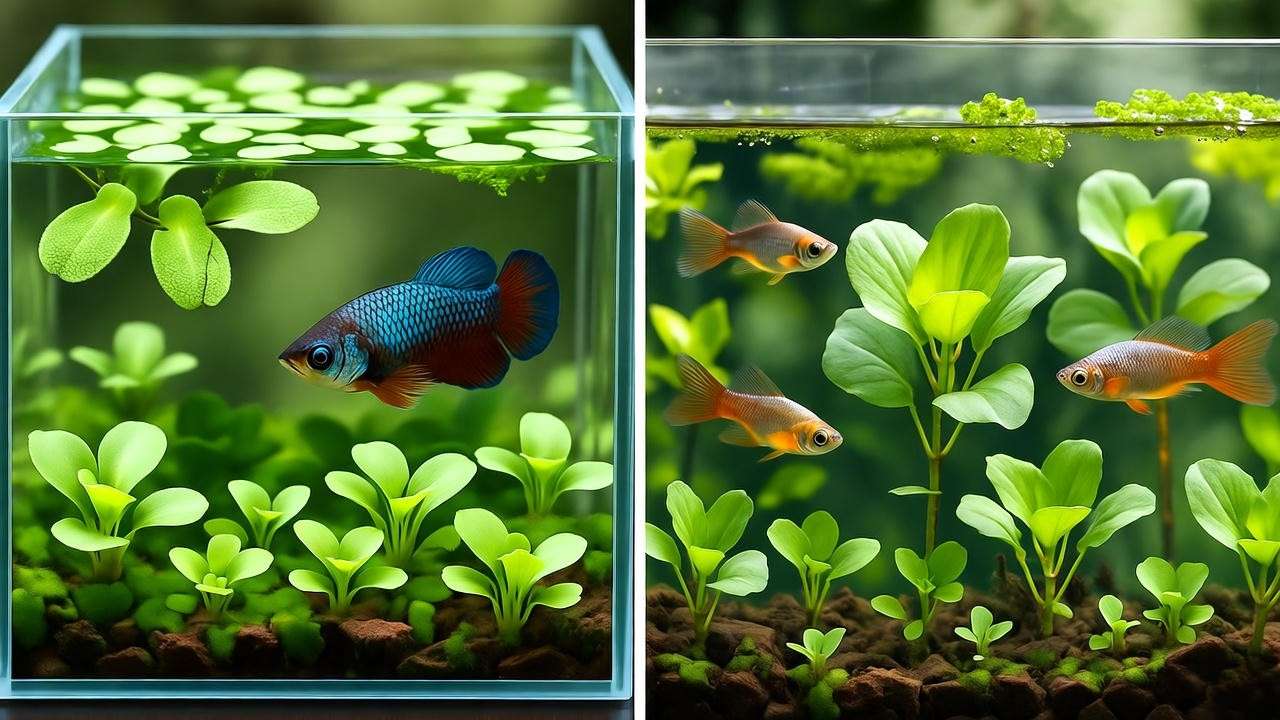
How to Care for Floating Aquarium Plants 🌿
Caring for floating aquarium plants is surprisingly simple, making them perfect for aquarists who want maximum impact with minimal effort. Below, we’ll cover essential care tips to keep your plants thriving and your tank healthy.
Lighting and Water Conditions
- Light Requirements: Floating plants vary in their light needs. Low-light plants like Hornwort and Azolla thrive with 5-10W LED lights, while high-light lovers like Red Root Floater and Water Hyacinth need 20W+ for vibrant growth. Most plants do well with 10-15W for balanced results. Aim for 8-10 hours of light daily to mimic natural conditions.
- Temperature: Most floating plants prefer warm water between 70-82°F. Avoid extremes—temperatures below 60°F can slow growth, while above 85°F may stress plants.
- Water Flow: Gentle water movement is ideal to prevent plants from clumping or getting stuck in filters. Strong currents can damage delicate roots, so adjust your filter output accordingly.
Pro Tip: Use a full-spectrum LED light to enhance plant growth and bring out vivid colors, especially for Red Root Floater and Water Hyacinth! 💡
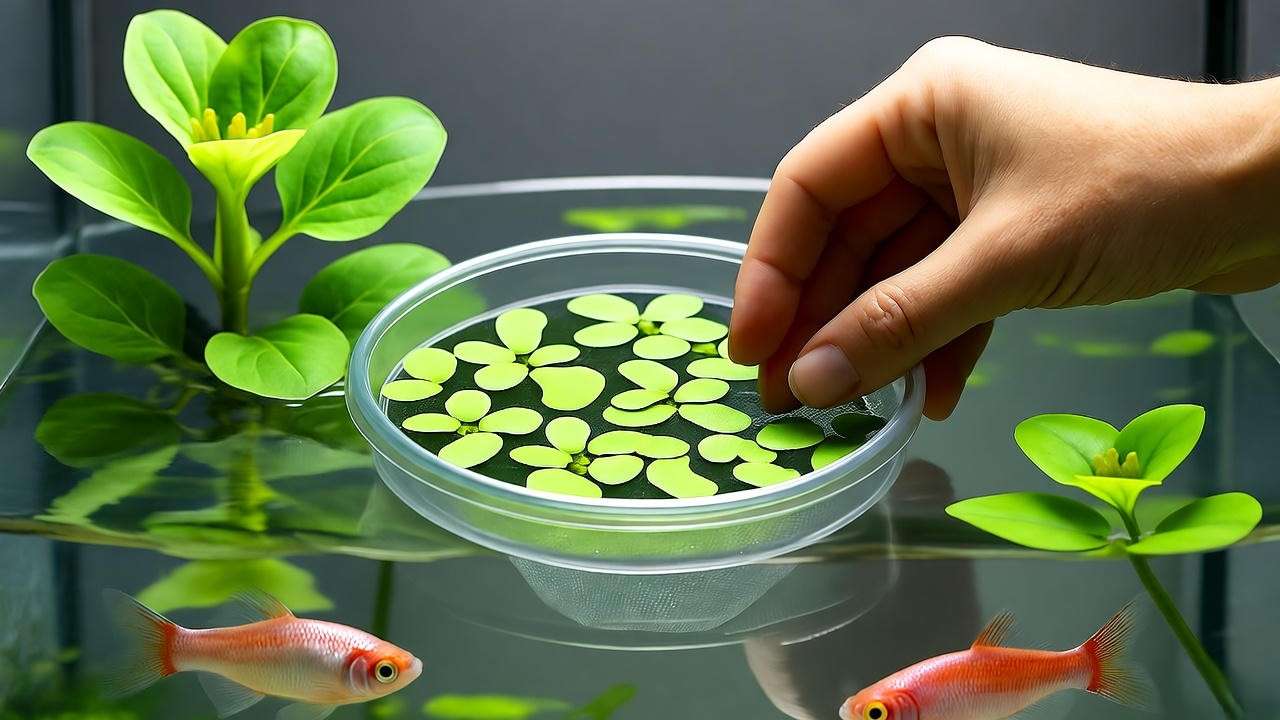
Maintenance and Pruning
- Thinning Fast-Growers: Plants like Duckweed and Azolla can multiply rapidly, covering the tank surface and blocking light. Thin them weekly by scooping out excess with a net to maintain 30-50% surface coverage.
- Root Trimming: For plants like Amazon Frogbit or Red Root Floater, trim long roots every 2-3 weeks to keep the tank tidy and prevent clogs in equipment.
- Removing Dead Leaves: Regularly check for yellowing or decaying leaves, especially in Water Lettuce or Salvinia, and remove them to maintain water quality.
Preventing Common Issues
- Overcrowding: Too many plants can reduce light penetration, stressing fish and submerged plants. Use a floating ring or divider to contain plants and ensure open water areas.
- Algae Competition: Floating plants naturally reduce algae by absorbing nutrients, but pairing them with algae-eating shrimp (like Amano shrimp) or fish (like Siamese algae eaters) enhances this effect.
- Nutrient Deficiency: If plants yellow or grow slowly, your tank may lack nutrients. Add a liquid aquarium-safe fertilizer (like Seachem Flourish) sparingly, as over-fertilizing can harm fish.
Expert Insight: Invest in a small quarantine tank to acclimate new floating plants before adding them to your main tank. This prevents introducing pests or algae. 🧼
Creative Ways to Use Floating Plants in Aquascaping 🎨
Floating aquarium plants aren’t just functional—they’re a canvas for creativity! Here are inspiring ways to incorporate them into your aquascape for a stunning, natural look:
- Create a Natural Canopy: Combine Water Lettuce and Amazon Frogbit to form a lush, layered canopy that mimics a tropical pond. This adds depth and provides shade for light-sensitive fish like neon tetras.
- Mix Colors and Textures: Pair the vibrant red roots of Red Root Floater with the soft green of Salvinia for a striking contrast. Add Floating Crystalwort for a mossy texture that elevates the design.
- Outdoor Ponds: Water Hyacinth and Azolla thrive in outdoor water gardens, creating a vibrant, eco-friendly display. Pair with koi or goldfish for a classic pond aesthetic.
- Breeding Tanks: Use Hornwort or Floating Crystalwort in breeding setups to provide hiding spots for fry. Their dense structure protects vulnerable young fish from predators.
Visual Idea: Imagine a tank with Water Lettuce in one corner, Red Root Floater adding pops of color in the center, and Hornwort floating loosely for a wild, natural vibe. This setup is both functional and visually captivating!
Pro Tip: Use driftwood or rocks to anchor some floating plants like Hornwort for a hybrid look, blending floating and rooted aesthetics. 🌾
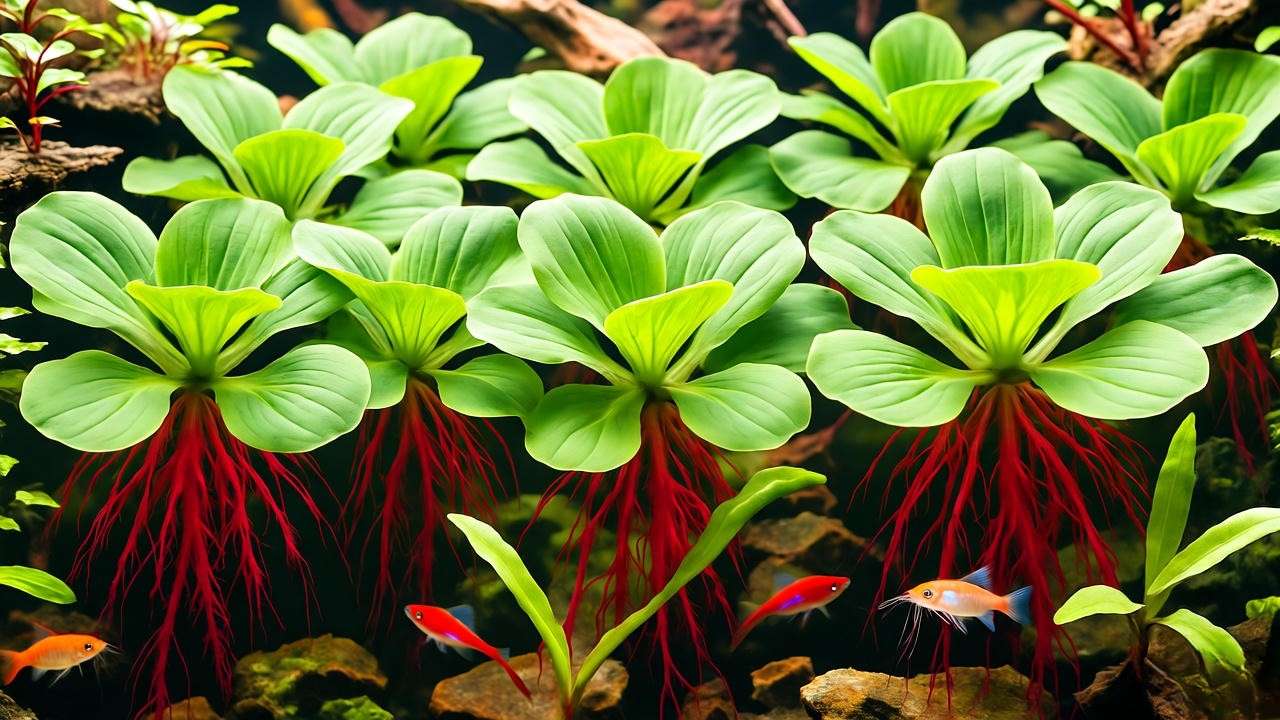
FAQs About Floating Aquarium Plants ❓
Q: Are floating aquarium plants safe for all fish?
A: Most are safe, but avoid delicate plants like Duckweed in tanks with aggressive fish like cichlids, which may tear them apart. Sturdier options like Hornwort or Water Lettuce are better for such setups.
Q: How do I prevent floating plants from taking over my tank?
A: Thin fast-growers like Duckweed or Azolla weekly, aiming for 30-50% surface coverage. Use containment rings or barriers to keep plants in designated areas and prevent filter clogs.
Q: Can floating plants survive in low-light tanks?
A: Absolutely! Hornwort, Salvinia, and Azolla thrive in low-light conditions (5-10W), making them perfect for low-tech setups.
Q: Do floating plants need fertilizer?
A: Only if your tank lacks nutrients (e.g., yellowing leaves or slow growth). Use aquarium-safe liquid fertilizers sparingly, following product guidelines to avoid harming fish.
Q: How do floating plants help with algae control?
A: They absorb excess nitrates and phosphates, starving algae of nutrients. Pair with algae-eaters for even better results.
Q: Can I mix different floating plants in one tank?
A: Yes! Combining plants with different light and nutrient needs (e.g., Duckweed and Red Root Floater) creates a balanced, visually appealing tank. Just monitor growth to avoid overcrowding.
Final Thoughts: Transform Your Tank with Floating Plants 🌊
Floating aquarium plants are a game-changer for aquarists seeking a low-maintenance, vibrant tank. From the tiny, nutrient-hungry Duckweed to the bold, tropical Water Hyacinth, these plants offer unmatched benefits: cleaner water, happier fish, and stunning aesthetics. Whether you’re a beginner dipping your toes into aquascaping or an expert crafting a masterpiece, there’s a floating plant for every tank. Start with beginner-friendly options like Duckweed or Amazon Frogbit, and watch your aquarium transform into a thriving ecosystem with minimal effort.
As an aquascaping enthusiast with over a decade of experience, I’ve seen floating plants turn ordinary tanks into extraordinary underwater gardens. My own 50-gallon community tank thrives with a mix of Water Lettuce and Hornwort, keeping water parameters stable and my fish happy. Ready to elevate your tank? Share your favorite floating plant in the comments or reach out for personalized aquascaping tips! Happy aquascaping! 🐠🌿

